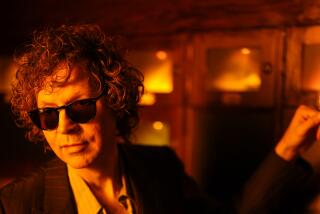Reading Music Is No Longer Enough; Now There’s Technology
- Share via
Eric Persing, who played some of the synthesizer intros on Michael Jackson’s “Bad” album, was giving new meaning to the term “one-man band” Friday at the Anaheim Convention Center, where crowds milled through the 19th Winter Market of the National Assn. of Music Merchants over the weekend.
Playing (take a big breath now) a keyboard-interfaced Roland S-550 rack-mounted sampler with an MC-500 sequencer loading sounds off a hard disk (made it?), he produced the urgent heavy metal scream of an entire 10-piece rock group--by himself.
“We talk in terms of sound modules these days instead of key signatures,” Persing explained briefly, glossing over the more abstruse details of such terms as “vector pads” and “fingered b.2’s.”
When Persing finished his solo session, his admiring audience drifted over to the adjacent bandstand. There, in pink shoes, yellow pants and a colorless shirt that looked like an afterthought, Paul Youngblood began to riff through what seemed like every guitar style known to the 20th Century.
The sign above him said: “A guitar is no longer just an axe with the MIDI converter.” For the record, MIDI stands for Musical Instrument Digital Interface, which allows synthesizers and computers to talk to each other, and Youngblood was playing (very big breath now) a guitar-interfaced rack-mounted Roland S-550, GM-70, D-110, S-220, MKS-50, GP-8, DEP-5, MKS-20, MI-60 (got it?).
He didn’t mind giving details. “Here’s an l/a sound,” he said, referring to a linear/arithmetic mode of play. “It has nothing to do with airplane noise or smog over Los Angeles. It’s just a clean guitar sound.”
In case the mystified or the just-plain-breathless wanted to know why, he explained: “I’m using the compressor, the chorus, the digital delay and a little bit of equalization with parametric on the MIDI.”
If traditional signatures are fading fast as musicians substitute the key of AC (Alternating Current), somebody has finally come to the rescue of old-fashioned acoustic instruments. Yes, the yuppies can take credit for a pleasure besides greed. At least that was the consensus of several respected instrument manufacturers.
“I hate to use the term yuppies, but they did it for us,” said Ron Griggs, standing by a huge showcase glowing with the luster of polished trumpets, tubas, french horns and saxophones. “They’re the baby boomers now and they want their 2.1 children to play 1.3 instruments. So the yuppie puppies are into school band programs.”
Griggs, vice president of sales for Le-Blanc Corp., said the Kenosha, Wis., company sold “in excess of $30 million” worth of horns last year. “We not only had the best year in our history,” he said, “but our profits were better than the previous three years put together.”
Chris Martin IV, board chairman of the Martin Guitar Co., which has manufactured hand-made acoustic guitars in Nazareth, Pa., for six generations, said his company sold about 5,000 instruments last year, up more than 15% over 1986. “There are a lot of people out there with disposable incomes who will pay for tone and quality in a guitar,” he said.
“The yuppies brought the acoustic market back,” said Dick DeWalt, a Martin company executive. Perhaps a bit wary that yuppies would do anything without financial planning, he hastened to add: “If you take good care of a Martin, you can realize a profit on it down the road.”
Still, the crowds at the convention tended to congregate around the high-tech exhibits, leaving acoustic instrument makers standing around looking comparatively forlorn.
At Hybrid Arts Inc., for instance, people gathered to hear somebody making music that sounded like World War III on a mesmerizing, weaponlike thing called an ADAP (Analogue Digital Audio Processor).
Alan Hart, who co-founded the Los Angeles-based company in 1983, acknowledged the beauty and warmth of acoustic instruments but didn’t hesitate to damn them with faint praise: “They’ll always be around. They’re nice furniture.” And for any accordion players within earshot, he offered a foxhole: “All they have to do is plug in. The ADAP is very accommodating.”
Ironically, acoustic pianos have made a comeback partly because interior decorators are indeed making use of them as living room status symbols. Said John Vincent, director of NAMM exhibits: “It’s fashionable to have a piano again.”
But if any of the merchants at the convention seemed to be grappling with the disparate forces converging on the music industry at once, it was Jon Richards, 31, of New Haven, Conn.
A portly, goateed gentleman who looked like a holdover from the be-bop era in his dark blazer and gray snap-brim fedora, he said he sells metronomes and violins by day and works as a digital analyst-cum-keyboard player by night.
“There’s a growing underground of rebellious musicians who would rather hear a flute sound coming from an acoustic flute and a violin sound coming from an acoustic violin and I’m one of them,” he said.
“But,” he admitted sadly, “when I play Top 40 tunes in a roadside gin mill, I don’t hire live musicians. The truth is I’d rather have them instead of an electronic substitute. The trouble is I can’t afford them.”
Meanwhile, traditional band instruments remain the foundation of a nearly $3-billion industry (including accessories and sheet music) that grew at retail last year by 10%, according to Larry W. Linkin, executive vice president of NAMM.
“The synthesizer/computer/MIDI thing is flying, no doubt about it,” said Linkin, a clarinetist. “Unless you play acoustic, though, you can’t play that technology as well.”
NAMM officials said the winter trade show, with 589 merchants participating, was their largest ever. About 32,000 people attended.
More to Read
The biggest entertainment stories
Get our big stories about Hollywood, film, television, music, arts, culture and more right in your inbox as soon as they publish.
You may occasionally receive promotional content from the Los Angeles Times.










